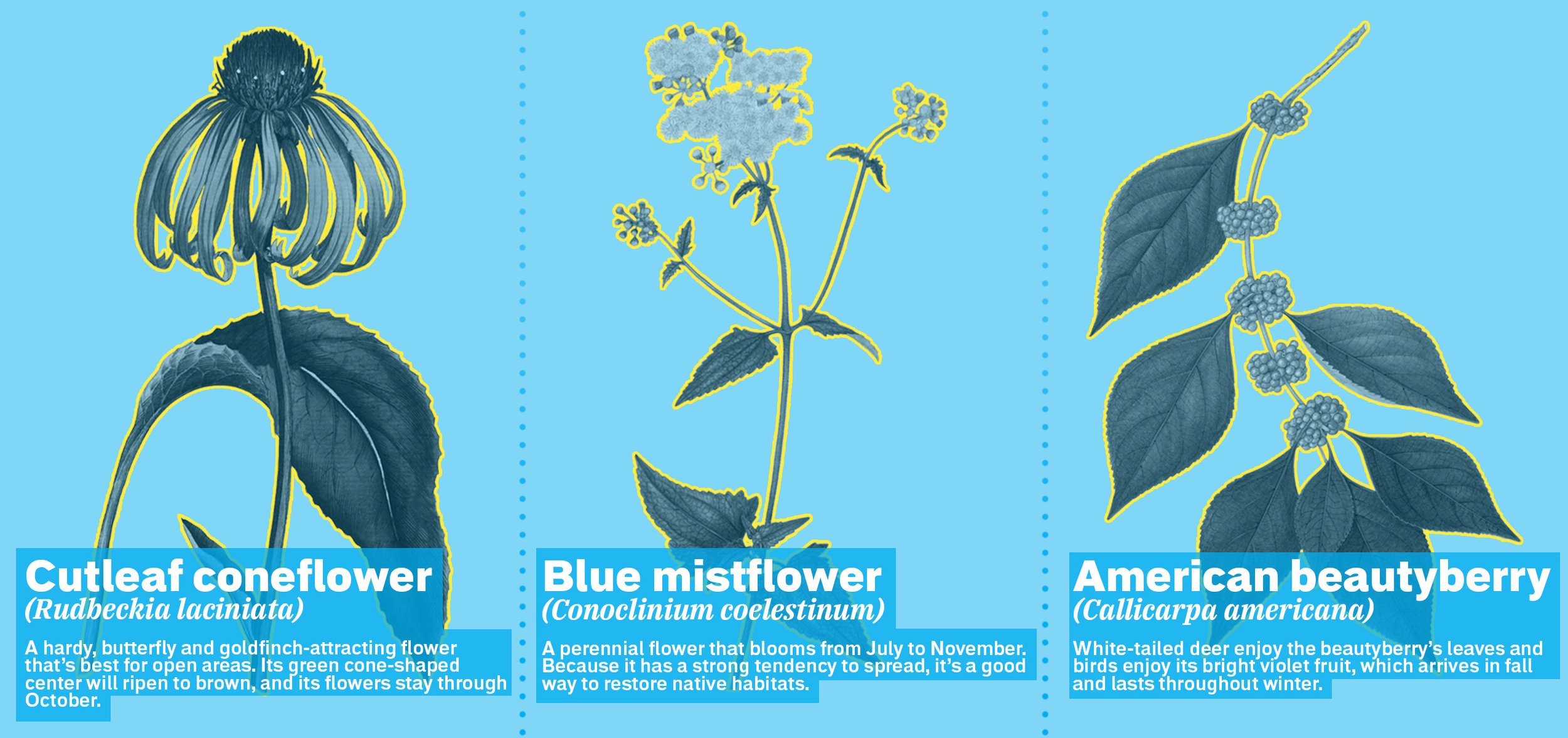Localize your lawn: How native plants help your yard and our ecosystem
Fall is the best time to plant perennials and wildflowers. Here are some tips for how to get started — and how to get reimbursed for buying native plants.
By Trista Ridge, Contributor
Fast facts
Native plants were here before we were, meaning they grew without our help, so they are accustomed to our soil, weather, and native species, and they will be the most resilient.
Got water pooling in your yard when it rains? Native plants can be a quick and simple piece of the solution
Native plants also support our local wildlife and improve air quality!
You can apply for a reimbursement for 75% of the what you spend on native plants through the City of Chattanooga’s SupportScapes program.
'Lawns are about as good as pavement'
To get a better idea of what Chattanoogans can do to make their yard a paradise for our local flora and fauna, we visited Reflection Riding’s native plant nursery and walked and talked with Hannah Lieffring, the nursery manager.
“Lawns are about as good as pavement or concrete,” said Lieffring. “There’s not a lot of benefit, especially when we’re mowing them to be so short and not allowing any weeds to grow.”
When our green spaces have native plants in them, pollinators are able to do their jobs more effectively. When plants are pollinated, they clean the air, stabilize soil, and supply oxygen. By providing food and shelter, native plants are also an important part of our local wildlife’s habitat. And native plants are good for water quality, too. When it rains, water runoff entering our streams and rivers can contain toxins and pollutants. If our soil is enriched with the root systems of native plants, it’s able to absorb more rain water and the plant can then filter out toxins.
“We are actively working toward changing Chattanoogans' mindsets in regards to their yards and how they can create a habitat, not just a landscape,” Lieffring said.
Replacing invasive with native
Like many places, Chattanooga has a problem with invasive species used as staple landscaping plants — while beautiful, they don’t do anything for the local ecosystem.
“A lot of times we try to landscape with plants we see our neighbors landscaping with, and Reflection Riding is trying to break that cycle,” Lieffring said.
Below is a list of invasive plants that you see often in Chattanooga, and natives you can plant instead.
Instead of Crepe Myrtles, plant:
Fringetree (Chionanthus virginicus)
False Indigo (Amorpha fruticosa)
Summersweet Clethra (Clethra alnifolia)
Eastern Redbud (Cercis canadensis)
Oakleaf Hydrangea (Hydrangea quercifolia)
Instead of monkey grass, plant:
Sedges, especially Cherokee Sedge (Carex cherokeensis) and Fox Sedge (Carex vulpinoidea)— they are similar in height/habit and provide more benefits for our wildlife.
Muhly Grass (Muhlenbergia capillaris)
Blue-eyed Grass (Sisyrinchium angustifolium)
Instead of a Tree of Heaven, plant Fragrant, Shining, or Smooth Sumac (Rhus aromatica, Rhus copallinum, Rhus glabra).
Instead of a Princess Tree, plant a Sweetbay Magnolia (Magnolia virginiana).
Instead of Butterfly Bushes, plant Blue Wild or White Wild Indigo Bushes (Baptisia australis; Baptisia alba).
More invasives and non-natives to avoid planting:
Privet
Nandina
Periwinkle
English Ivy
Bush Honeysuckle
Bamboo
If you’re looking out at your manicured lawn and a driveway lined with crepe myrtles, don’t sweat it — turning your yard into a native plant paradise is a 3-5 year project, and even small changes help a lot.
From unused lawn to backyard sanctuary
Marco Perez stands in his backyard, in an area that used to be a lawn.
Local resident (and school board representative) Marco Perez recently set out on a multi-month process of transforming his backyard from grass and overgrown shrubbery into a haven for native plants. Perez had one goal for the backyard: “I want to feel peace in my backyard, I want to come here and escape.” He enlisted the help of a Wild Violet Permaculture, a local landscaper who specializes in native plants.
After many months, the backyard, which Perez estimates is several thousand square feet in size, has been transformed from a space that was never used, to a backyard that the family can spend time in.
"I can sit there for hours and enjoy the birds and enjoy the plants," Perez said.
Where to get native plants
In addition to the nursery at Reflection Riding, there are several other native nurseries and online seed sellers in the area. The Tennessee Valley Chapter of Wild Ones has compiled a list of native plant sellers here.
Reflection Riding's fall plant presale is happening now.
Get reimbursed for most of your costs
The City of Chattanooga’s SupportScapes program is an incentive program for residents to plant native plants. There are guidelines you must follow, but the program will reimburse 75% of your costs, up to $500.
These are the guidelines:
Edible native plants cannot comprise more than 25% of your SupportScape planting
A SupportScape must have a minimum of 15 plants installed
Existing beds are not eligible for reimbursement through SupportScapes. A SupportScape planting must be replacing lawn, turf, bare soil, areas affected by erosion, or invasive plants for the benefit of water quality & reduction of it's quantity
No seed mixes
Reimbursable materials are limited to native plants, topsoil, mulch, & compost
Learn more here.


